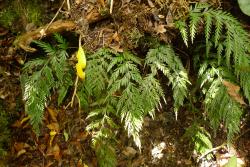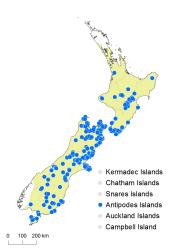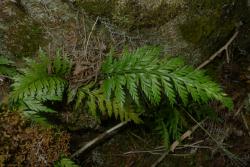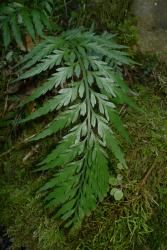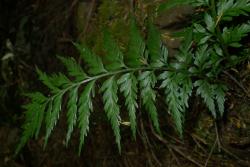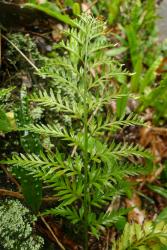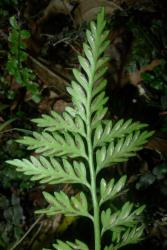- = Asplenium terrestre Brownsey, New Zealand J. Bot. 15: 71 (1977) subsp. terrestre
Rhizome scales 10–25 mm long, 0.5–2 mm wide. Fronds 80–640 mm long. Stipes 15–290 mm long. Laminae 2-pinnate to 2-pinnate-pinnatifid or rarely 1-pinnate-pinnatifid in the smallest fronds and 3-pinnate in the largest, ovate or elliptic or narrowly elliptic, narrowed to a pinnatifid apex, 40–480 mm long, 15–200 mm wide, coriaceous. Primary pinnae in 4–22 pairs below pinnatifid apex; proximal pinnae and those at mid-lamina narrowly ovate or ovate; the longest 12–215 mm long, 4–58 mm wide, apices acute to acuminate. Secondary pinnae gradually decreasing in length along each primary pinna to the distal end; the longest proximal secondary pinnae narrowly ovate or ovate or elliptic, 6–65 mm long (very rarely up to 100 mm long), 2–11 mm wide; the distal secondary pinnae straight or falcate, 3–12 mm long, 1–1.5 mm wide, apices acute or acuminate. Indusia 2–8 mm long.
Asplenium appendiculatum subsp. appendiculatum occurs from about Raglan and Mt Hikurangi southwards but is largely absent from the west coast of the South Island. It is distinguished from the more widespread A. flaccidum subsp. flaccidum by its usually terrestrial habitat, its upright and more divided fronds, its octoploid rather than tetraploid chromosome number, and its larger and more prominently ridged spores.
It is morphologically similar to A. richardii, and the two taxa often grow in close proximity. However, A. appendiculatum subsp. appendiculatum has more coriaceous fronds with pinnae that lie in one plane rather than spreading in three dimensions, ultimate segments that are slightly wider (1–1.5 mm, cf. 0.5–1 mm wide), and indusia that are generally longer (2–8 mm, cf. 1.5–4 mm long).
North Island: Auckland, Volcanic Plateau, Gisborne, Taranaki, Southern North Island.
South Island: Western Nelson, Sounds-Nelson, Marlborough, Westland, Canterbury, Otago, Southland.
Stewart Island, Antipodes Islands.
Altitudinal range: 5–1525 m.
There are isolated records of Asplenium appendiculatum subsp. appendiculatum from Waingaro near Raglan Harbour and Mt Hikurangi in the Raukūmara Range, but it occurs more commonly from Lake Taupō southwards in lowland to subalpine areas of the North Island, mainly in the Hawke’s Bay ranges, the Ruahine Range, Mt Taranaki and southern Wairarapa; it grows from near sea level up to about 1450 m on Mt Hikurangi, but is uncommon below about 300 m, except in Wairarapa. In the South Island it occurs mostly east of the main divide in lowland to subalpine areas, growing from near sea level in the Marlborough Sounds up to 1525 m on Mt Fyffe in the Seaward Kaikōura Mountains. It is absent from Fiordland, but extends to Stewart Island and the Antipodes Islands.
Also Australia (Victoria, Tasmania).
A terrestrial fern that occurs under podocarp, broadleaved and beech forest, in mānuka, kānuka, and low scrub, in tussock grassland, under introduced pine plantations and under other exotics in urban environments. On Antipodes Island it grows under tussocks and occasionally as a low epiphyte on Coprosma antipoda. It grows on the forest floor, on fallen trunks, cliffs, banks, streamsides, boulders, in rock crevices, under rock overhangs, and occasionally as a low epiphyte. It is found on greywacke, sandstone, schist, limestone, marble, and ultramafic rock types.
There is evidence that A. appendiculatum subsp. appendiculatum hybridises with A. flaccidum subsp. flaccidum, A. hookerianum, A. lyallii, A. richardii (Brownsey 1977a), A. gracillimum (Brownsey 1983), A. lepidotum (Perrie & Brownsey 2016) and A. bulbiferum (newly recorded here).
n = 144 (Brownsey 1977b, as A. terrestre subsp. terrestre), n = c. 140 (Beuzenberg in Godley 1989, as A. terrestre).
The names Asplenium canterburiense J.B.Armstr., Trans. & Proc. New Zealand Inst. 14: 361 (1882) and Asplenium bulbiferum var. canterburiense (J.B. Armstr.) C.Chr., Index Fil. 104 (1905) have been used in relation to A. appendiculatum subsp. appendiculatum, but the only extant specimen in the Armstrong herbarium (CHR 633317) has aborted spores and is a hybrid of parentage A. appendiculatum subsp. appendiculatum × richardii (Brownsey 1977b).



